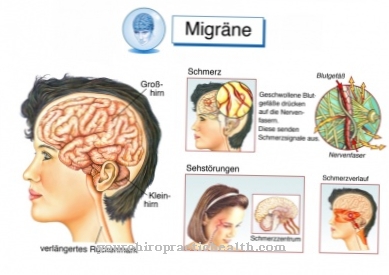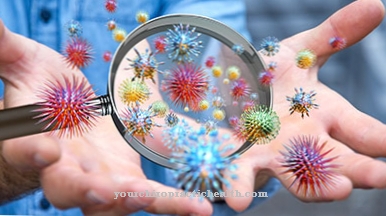Patients with certain underlying diseases such as kidney failure or underactive adrenal gland (Addison's disease) as well as patients who take diuretics in combination with antihypertensive agents should contact a Hyperkalemia think and see a doctor if you suddenly experience a furry feeling on your tongue or a tingling sensation on your skin. Cardiac arrhythmias can result from this disorder.
What is hyperkalemia?

© Yulia Furman– stock.adobe.com
At a Hyperkalemia the patient's electrolyte balance is disturbed and the potassium level in the blood is higher than normal. For adults this value should not be higher than 5.0 mmol / l and children not higher than 5.4 mmol / l.
In most cases, chronic kidney failure leads to hyperkalaemia; more rarely, antihypertensive drugs such as ACE inhibitors or diuretic drugs are the trigger of the disorder. It manifests itself in the patient as a tingling sensation on the skin and a furry feeling on the tongue.
It can also lead to paralysis and muscle weakness. If left untreated, hyperkalemia is an extremely threatening condition as it can lead to abnormal heart rhythms. In addition, this can lead to ventricular fibrillation with subsequent cardiac arrest.
causes
The Hyperkalemia refers to the increase in the level of potassium in the blood. In the case of chronic kidney failure, the kidneys can no longer adequately excrete the potassium present.
However, since the concentration of potassium is crucial for the transmission of impulses from the heart muscle, cardiac arrhythmias can occur that are life-threatening for the patient. Hyperkalemia can occur intermittently during infusion therapy or as a result of the breakdown of the red blood cells, as occurs after extensive burns.
An increase in the potassium level in the blood can also occur during chemotherapy. Hyperkalemia can also occur if the patient is very acidic, known as acidosis. Drugs such as beta blockers and ACE inhibitors to lower blood pressure, as well as diuretics, can also lead to hyperkalemia.
Typical symptoms & signs
- tingle
- Muscle twitching (fasciculation)
- Cardiac arrhythmias
- Cardiac arrest (cardiovascular failure)
Diagnosis & course
In the anamnesis interview, the patient's information already suggests a Hyperkalemia if the patient reports typical symptoms such as a furry feeling on the tongue and a tingling sensation on the skin.
Muscle weakness and symptoms of paralysis as well as ringing in the ears can also occur before the cardiac arrhythmias. The diagnosis of the disorder is made by the doctor using a laboratory test of the blood. To do this, the electrolyte values potassium and sodium as well as calcium and chloride and other enzyme values are determined. Conclusions about kidney function can be drawn from the creatinine level.
The pH of the blood and the acid-base status are also used to diagnose hyperkalaemia. Since cardiac arrhythmias can be the result of hyperkalaemia and if left untreated, this can be fatal, an EKG (electrocardiogram) is also made to check the cardiac function and to identify any disturbances immediately.
Complications
Hyperkalemia can be fatal in some cases, but is not always fatal. For this reason, a competent assessment and treatment by a doctor is required in individual cases. Cardiac complications, including cardiac arrhythmias, ventricular fibrillation and cardiovascular arrest, are particularly problematic. Such abnormalities in the heart rhythm can be made visible with the help of an electrocardiogram (EKG).
The hyperkalemia often stems from another condition. Without treatment of the underlying disease (if possible) and hyperkalemia, the condition may worsen. Symptoms of hyperkalemia include paresthesia and muscle weakness. Both can increase the risk of accidents in critical situations (for example when driving machines and vehicles or when working on scaffolding).
Injuries and falls that may occur may also need treatment. Furthermore, psychological symptoms such as confusion and hallucinations are possible with hyperkalemia. They can mean that those affected are not aware of their own condition or cannot communicate clearly. These circumstances can make diagnosis and treatment difficult. The confusion of the person concerned can also contribute to the fact that other people also misjudge the situation and are thereby “deterred”.
When should you go to the doctor?
Patients with kidney disease should see a doctor for ringing in the ears, muscle weakness, and other unusual symptoms. If symptoms such as cardiac arrhythmias or persistent muscle twitching arise, a doctor must be consulted immediately. Emergency medical help is required in the event of severe complications. In the event of cardiac arrest or signs of a heart attack, the emergency services should be alerted immediately. In addition, first aid measures must be provided. The patient then has to spend a few days in the hospital. Further medical check-ups are indicated depending on the course and the underlying disease.
Hyperkalemia is associated with various kidney diseases. These include kidney failure, underactive adrenal glands, and kidney cancer. There is also an increased risk of an excessively high potassium level in the blood during chemotherapy or after extensive burns. Anyone who belongs to these risk groups should have these symptoms clarified by a doctor. Suitable contacts are the family doctor or a nephrologist. In the event of a medical emergency, the emergency doctor must always be called.
Doctors & therapists in your area
Treatment & Therapy
Treatment of the Hyperkalemia depends on its cause. If drugs are the cause of the disorder, they are discontinued or replaced with other drugs. Medications that reduce the absorption of potassium in the intestines can also be prescribed.
If the potassium level is very high, however, the patient must be given intensive care because he is in a life-threatening condition. Under constant ECG monitoring, he receives a combination of drugs that stimulate urine production in the kidneys on the one hand and promote the absorption of potassium in the body's cells on the other.
Simultaneous administration of insulin and glucose also promotes potassium absorption. The aim of these measures is to lower the potassium level in the blood and thus protect the heart muscle. Calcium infusions can also help prevent arrhythmias. If these therapeutic measures do not have an adequate effect, the potassium level can also be reduced by washing the blood and thus the hyperkalaemia can be eliminated.
You can find your medication here
➔ Medicines for cardiac arrhythmiasOutlook & forecast
The oversupply of potassium in the organism is caused by an underlying disease. Therefore, the alleviation of the symptoms of hyperkalemia depends on the prospect of a cure for the disease that has already been diagnosed and treated.
Patients with a tumor disease have a good chance of a cure if the tumor was detected early and successfully removed. If there are no metastases in the body, it usually takes several years to achieve full recovery. Since the hyperkalemia usually develops as a side effect of the cancer therapy initiated, the symptoms can only be alleviated after the necessary chemotherapy has ended. If the cancer is considered cured, the hyperkalemia is also cured. Otherwise, the treatment of the patient is switched to the alleviation of serious complaints and no cure for the hyperkalemia is sought.
In the case of a functional disorder of the kidney, the excess of potassium produced can only be reduced if the treatment of the kidney is successful or an organ donation has taken place. Cure is possible through a kidney transplant if the donor organ has been successfully accepted by the body. Basically, the overall prognosis is based on the kidney disease and its treatment options.
If the hyperkalemia arose as a result of the administration of medication, the symptoms can be completely reduced in most patients within a short time by using substitute preparations.
prevention
A Hyperkalemia occurs very rarely. In the case of certain underlying diseases such as kidney failure and Addison's disease, as well as in patients who have to take diuretic and antihypertensive medication, the potassium level in the blood should be checked regularly so that countermeasures can be taken immediately at the first signs of hyperkalemia.
Aftercare
In the case of hyperkalaemia, the measures or the possibilities of follow-up care are usually severely limited, so that the early detection with subsequent treatment is the focus of this disease. A doctor should be contacted at the first signs and symptoms of this disease in order to prevent further complications or to prevent the disease from worsening. An early diagnosis always has a positive effect on the further course of the hyperkalemia.
Most of the time, the disease is treated by taking medication, although some medications must be stopped first. Attention should be paid to the correct dosage and regular intake. In the event of interactions or side effects, a doctor should always be consulted first. Dialysis may be necessary in severe cases.
As a rule, those affected need the support and help of friends and family. Loving care and support always has a positive effect on the further course of the disease. Contact with other hyperkalaemia patients can also be useful. In many cases this disease reduces the life expectancy of the person affected.
You can do that yourself
Hyperkalemia is a disease that the patient cannot diagnose himself. Often their only symptom is cardiovascular arrest. In most cases, however, it will be detected through a routine blood count. The treatment of hyperkalemia is based on a medically drawn up therapy plan that the patient should conscientiously adhere to. Essentially, it is about getting the excess potassium out of the body and then making sure that no further excess builds up.
The kidneys are mainly responsible for excreting the potash. The patient can support the process by adapting their lifestyle habits so that the kidney function is strengthened and supported as much as possible. This includes compliance with certain diet regulations that relieve the kidneys. In this context, it is also very important to flush the kidneys well and thus make their work easier. Patients affected by hyperkalemia should therefore drink a lot during therapy and later as a preventive measure. Two to three liters a day are ideal. Still mineral water is recommended, but unsweetened fruit teas or diluted juices also have a positive effect on kidney function.
Since hyperkalaemia often interactions with other drugs, it is necessary for the patient to give their doctor precise information about the drugs they have taken and not to take additional therapeutic measures themselves.













.jpg)

.jpg)
.jpg)











.jpg)